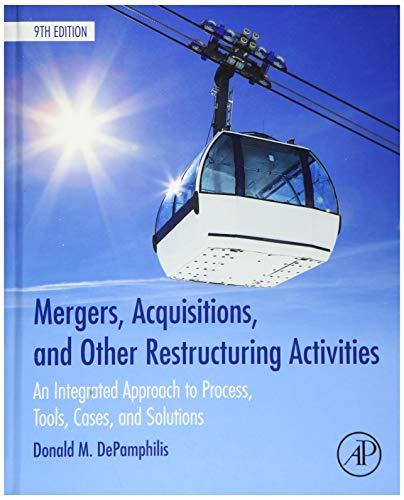Life Technologies Corporation (Life Tech) and Thermo Fisher Scientific Inc. (Thermo Fisher) was completed on January 14,
Question:
Life Technologies Corporation (Life Tech) and Thermo Fisher Scientific Inc. (Thermo Fisher) was completed on January 14, 2014. Thermo Fisher is the largest provider by market value of analytical instruments, equipment, reagents and consumables, software, and services for scientific research, analysis, discovery, and diagnostics applications. Life Tech is the second largest by market value provider of similar products and services to the scientific research and genetics analysis communities.
While the fanfare surrounding the closing echoed sentiments similar to those expressed when the deal was first announced, the hard work of integrating the two firms was just beginning. What led to this moment illustrates the power of financial models.
Life Tech had been evaluating strategic options for the firm since mid-2012, concluding that putting itself up for sale would be the best way to maximize shareholder value (see the Case Study at the end of Chapter 9 titled “Life Tech Undertakes a Strategic Review” for more detail). After entering into discussions with Thermo Fisher in late 2012, the two firms announced jointly on April 15, 2013, that they had reached an agreement to merge. Exuding the usual optimism accompanying such pronouncements, Mark N. Casper, president and chief executive officer of Thermo Fisher, stated,
“We are extremely excited about this transaction, because it creates the ultimate partner for our customers and significant value for our shareholders … enhancing all three elements of our growth strategy: technological innovation, a unique customer value proposition, and expansion in emerging markets.” Expressing similar confidence, Greg T. Lucier, chairman and chief executive officer of Life Tech, noted, “This transaction brings together two companies intent on accelerating innovation for our customers and achieving greater success in a highly competitive global industry.”
This case study utilizes the publicly announced terms of the merger of Life Tech into a wholly owned subsidiary of Thermo Fisher, with Life Tech surviving. The terms were used to develop pro forma financial statements for the combined firms. These statements are viewed as a “base case.”44 The financial model discussed in this chapter is used to show how changes in key deal terms and financing structures impacted the base case scenario. The discussion questions following the case address how the maximum offer price for Life Tech could be determined, what the impact of an all-debt or all-equity deal would have on the combined firms’ financial statements, and the implications of failing to achieve synergy targets. Such scenarios represent the limits of the range within which the appropriate capital structure could fall and could have been part of Thermo Fisher’s predeal evaluation. As announced by Thermo Fisher, the appropriate capital structure is that which maintains an investment grade credit rating following the merger. Thermo Fisher’s senior management could have tested various capital structures between the two extremes of all-debt and all-equity before reaching agreement on the form of payment with which they were most comfortable.
Therefore, the form of payment and how the deal was financed were instrumental to the deal getting done....
Discussion Questions:
1. Thermo Fisher paid \($76\) per share for each outstanding share of Life Tech. What is the maximum offer price Thermo Fisher could have made without ceding all of the synergy value to Life Tech shareholders? (Hint: Using the Transaction Summary Worksheet, increase the offer price until the NPV in the section entitled Valuation turns negative.) Why does the offer price at which NPV turns negative represent the maximum offer price for Life Tech? Undo changes to the model before answering subsequent questions.
2. T hermo Fisher designed a capital structure for financing the deal that would retain its investment grade credit rating. To do so, it targeted a debt-to-total capital and interest coverage ratio consistent with the industry average for these credit ratios. What is the potential impact on Thermo Fisher’s ability to retain an investment grade credit rating if it had financed the takeover using 100% senior debt? Explain your answer. (Hint: In the Sources and Uses section of the Acquirer Transaction Summary Worksheet, set excess cash, new common shares issued, and convertible preferred shares to zero. Senior debt will automatically increase to 100% of the equity consideration plus transaction expenses.50) Undo changes to the model before answering subsequent questions.
3. A ssuming Thermo Fisher would have been able to purchase the firm in a share for share exchange, what would have happened to the EPS in the first year? Explain your answer. (Hint:
In the form of payment section of the Acquirer Transaction Summary Worksheet, set the percentage of the payment denoted by “% Stock” to 100%. In the Sources and Uses Section, set excess cash, new common shares issued, and convertible preferred shares to zero.) Undo changes made to the model before answering the remaining question.
4. Mark Fisher, CEO of Thermo Fisher, asked rhetorically what if synergy were not realized as quickly and in the amount expected. How patient would shareholders be if the projected impact on earnings per share was not realized? Assume that the integration effort is far more challenging than anticipated and that only one-fourth of the expected SG&A savings, margin improvement, and revenue synergy are realized. Furthermore, assume that actual integration expenses (shown on Newco’s Assumptions Worksheet) due to the unanticipated need to upgrade and colocate research and development facilities and to transfer hundreds of staff are \($150\) million in 2014, \($150\) million in 2015, \($100\) million in 2016, and \($50\) million in 2017.
The model output resulting from these assumption changes is called the Impaired Integration Case.
Step by Step Answer:

Mergers Acquisitions And Other Restructuring Activities
ISBN: 9780128016091
9th Edition
Authors: Donald DePamphilis





